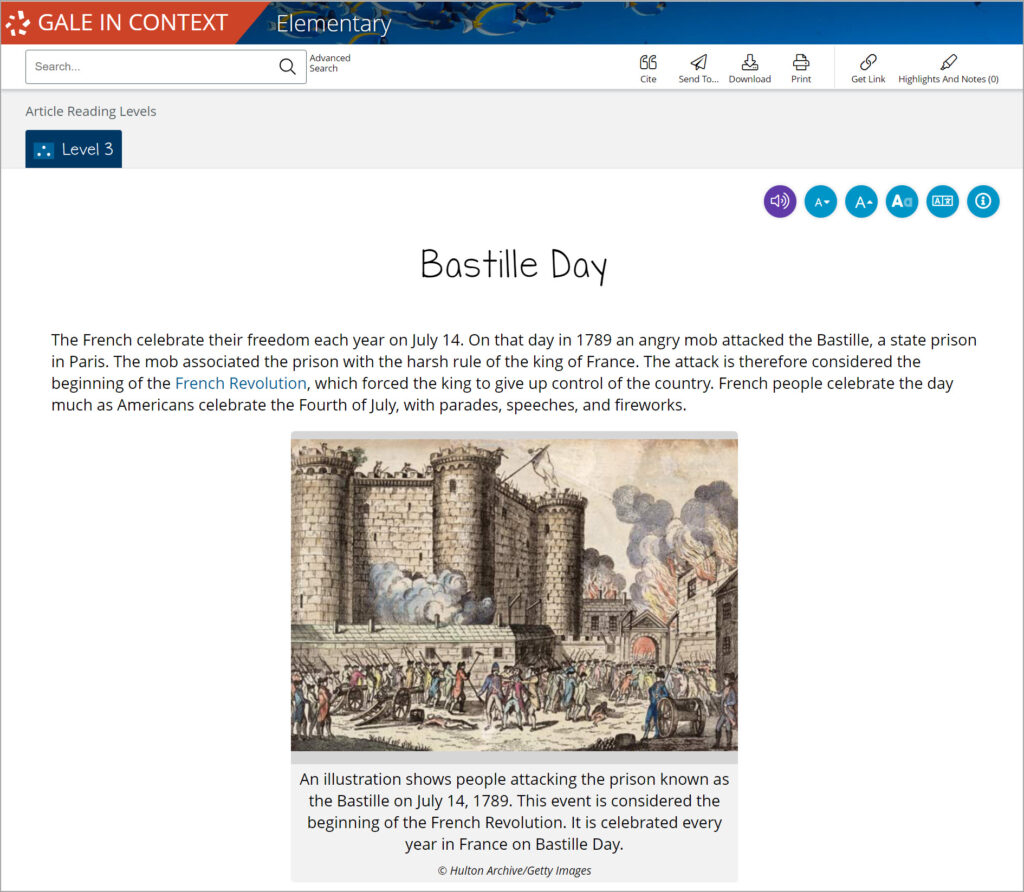| By Gale Staff |
Your young students are undoubtedly familiar with the basics of Independence Day in the United States. They’ve likely attended a fireworks show and have a general idea about our country’s Revolutionary War against Great Britain. Of course, for most Americans, the modern-day Fourth of July is a holiday defined by barbecues and sparklers rather than muskets and tricorn hats. Still, teachers can build lesson plans around either interpretation. The content in Gale In Context: Elementary can help you develop fun activities and discussion topics for Independence Day that engage all students, no matter their backgrounds.
Explore Independence Day with Your Students
Use Independence Day as an opportunity to practice research skills with young learners. Gale In Context: Elementary makes it easy for students to quickly grasp the search features and navigation tools. Have them start by simply entering “Fourth of July” into the search bar. Students will immediately find organized results, and you can feel confident knowing the content is age-appropriate and accurate. Plus, our interface leans on colorful visuals, including images, charts, and videos, making online research effective, kid-friendly, and fun.
For most topics, Gale includes a basic, easy-to-read summary to help get every child on the same page. After all, students with families from other countries may not be as familiar with the history and customs of Independence Day in the United States. These simple summaries are available in different languages and reading levels, giving students the customization tools they need to learn. Resources housed in Gale can even be downloaded as an audio file or visually changed to make the information more accessible.
Discuss Independence Days Around the World
The Fourth of July is specific to the United States but consider asking your students if they know of any other countries that celebrate their own Independence Day. If you have international or dual-citizen students, they may be able to share their culture’s national holiday. For example, France’s Bastille Day is July 14, Mexico’s Mexican Independence Day is September 16, and Canada’s Canada Day is July 1. Ask your students why these types of holidays are important and discuss how the celebrations differ between countries.

Gale In Context: Elementary can help encourage your students’ curiosity about the world around them, and the diversity of content helps raise awareness for other people’s stories. The viewpoints housed in Gale strive to ensure that all students can relate to the information they find and can see themselves in the narrative. Gale In Context: Elementary helps build equity in the classroom; when students access positive, unbiased information about different cultures, they develop the empathy and tolerance they’ll need to succeed outside of school.
Discover Teacher-Specific Assistance
New to Gale products? Gale In Context: For Educators is a comprehensive database for teacher-specific professional development and tips. Plus, we’ve even compiled ready-made lesson plans so you can spend more time with your students. This innovative product is designed to make your job a little easier while ensuring that your lesson plans remain meaningful and effective.
Find pre-recorded webinars with tips for online teaching strategies and for mastering Gale’s accessibility tools. We’ve designed these resources so you can access them on your own time and at your own speed. And, because not everyone is on the same level when it comes to educational technology, Gale In Context: For Educators features easy tutorials to help you integrate our resources within your institution’s learning management system, including Google Classroom and Canvas. Access printable quick start guides and tip sheets to leave beside your workstation so you can easily reference the shortcuts and workflows you need.
Design Hands-On Activities
Teachers will love Gale In Context: Elementary’s built-in projects and games. Find Fourth of July crossword puzzle clues and other fun ideas for celebrating in your classroom. Encourage your students to share if and how they recognize the holiday with their own families. Maybe even try some of these popular activities listed below:
- Learn new words: Young children have likely sung the “Star Spangled Banner” before, but the actual words are not the easiest to understand. What is meant by spangled, and what exactly is a rampart? Introduce your lesson by discussing the song’s history and then work through the lyrics together.
- Make an American flag: Using construction paper, help your students create an American flag to celebrate Independence Day. Work together and discuss what the different stripes, colors, and stars mean. Learn why the flag is an important symbol and how to respectfully treat one. For an extra level of engagement, introduce students to national flags from other countries as well.
- Try fun science experiments: Independence Day can be incorporated into more subjects than history or social studies. Why not try some fun, themed science lessons? The Ontario Science Center has an easy experiment using food coloring and oil to make fireworks in a jar. This lesson invites an important discussion on firework safety too. For another hands-on project, show kids how to make their own red, white, and blue tie-dye shirts.
Whether you’re creating engaging lessons before school wraps up for summer or facilitating summer-school classes, Independence Day is an exciting topic for your elementary learners. Gale In Context: Elementary is a database created for kids that helps teachers gently develop their students’ research skills. Should you need any guidance on how to use these tools, turn to the supplemental teaching materials in Gale In Context: For Educators.
If your school isn’t a current Gale subscriber, contact your local Gale rep to learn more about the different collections available!

